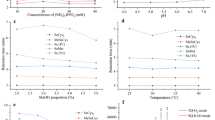Abstract
Total selenium content and its distribution in the soluble and insoluble protein-bound fractions obtained after aqueous extraction of antarctic krill samples were determined. About 26% of the total selenium (2.4 μg g−1 dry weight) was found in the supernatant; the rest was in the pellet. Isolation of low molecular selenium-containing fractions was also performed by enzymatic digestion of the protein, followed by size-exclusion chromatography in conjunction with atomic absorption spectrometry. From the applied various proteinases (pronase E, subtilisin Carlsberg, trypsin, chymotrypsin, proteinase and proteinase N from Bacillus subtilis and Novo 0.6 MPX enzyme), the treatment with pronase E led to best recovery of selenium. About 96% of the total Se was found in the hydrolysate, mainly in low molecular weight fractions. Eighty percent of the Se species were in fractions with molecular weights in the range of amino acids and short peptides. High-performance liquid chromatography/inductively coupled plasma mass spectrometry (HPLC-ICP-MS) allowed the identification of selenomethionine and the assumption that selenocystine or its derivatives were the main species in these fractions.



Similar content being viewed by others
References
Badmaev V, Majeed M, Passwater RA (1996) Altern Ther Health Med 2:59–67
Oster O, Prellwitz W (1990) Biol Trace Elem Res 24:91–103
Meuillet E, Stratton S, Prasad Cherukuri D, Goulet AC, Kagey J, Porterfield B, Nelson MA (2004) J Cell Biochem 91:443–458
Schrauzer GN (1983) Neuere Entwicklungen aus der Biologie, Biochemie und Medizin. Fischer, Heidelberg Germany
Ihnat M (1989) Occurrence and distribution of selenium. CRC Press, Boca Raton
Valiente L, Piccinna M, Smichowski P (2000) Toxicol Environ Chem 74:1–7
Barbante C, Cozzi G, Capodaglio G, Cescon P (2000) J Anal At Spectrom 15:377–382
Bernard JB, Allen ME (1997) Feeding captive piscivorous animals: nutritional aspects of fish as food. In: Proceedings of the 2nd conference of the Nutrition Advisory Group (NAG) of the American Zoo and Aquarium Association on Zoo and Wildlife Nutrition. Ft. Worth, TX, October 16–19
Lobinski R, Edmonds JS, Suzuki KT, Uden PC (2000) Pure Appl Chem 72:447–461
Emteborg H, Bordin G, Rodriguez AR (1998) Analyst 123:245–253
Lindemann T, Prange A, Dannecker W, Neidhart B (2000) Fresenius J Anal Chem 368:214–220
Kotrebai M, Tyson JF, Block E, Uden PC (2000) J Chromatogr A 866:51–63
Quijano MA, Moreno P, Gutierrez AM, Perez-Conde MC, Camara C (2000) J Mass Spectrom 35:878–884
Ruiz Encinar J, Ouerdane L, Buchmann W, Tortajada J, Lobinski R, Szpunar J (2003) Anal Chem 75:3765–3774
Gilon N, Astruc A, Astruc M, Potin-Gautier M (1995) Appl Organomet Chem 9:623–628
Potin-Gautier M, Gilon N, Astruc M, De Gregori I, Pinochet H (1997) Int J Environ Anal Chem 67:15–25
Kotrebai M, Bird SM, Tyson JF, Block E, Uden PC (1999) Spectrochim Acta B 54:1573–1591
Bird SM, Uden PC, Tyson JF, Block E, Denoyer E (1997) J Anal At Spectrom 12:785–788
Önning G (2000) Food Chem 68:133–139
Compère P, Jaspar-Versali MF, Goffinet G (2002) Biol Bull 202:61–73
Cappon CJ, Smith JC (1982) J Anal Toxicol 6:10–21
Acknowledgements
The authors would like to thank Drs. H. Helmholz and J. Bergmann (Institute for Coastal Research, GKSS Geesthacht) for the discussions and the support in HPLC-ICP-MS analysis, Mr. V. Klatt and Mr. V. Block (Central Analytical Laboratory of the Technical University Hamburg-Harburg) for their assistance in GF-AAS analysis. This work has been financially supported by GKSS Research Centre, Geestacht, fund for Cooperation with Universities (Hochschulzusammenarbeit).
Author information
Authors and Affiliations
Corresponding author
Rights and permissions
About this article
Cite this article
Siwek, M., Galunsky, B. & Niemeyer, B. Isolation of selenium organic species from antarctic krill after enzymatic hydrolysis. Anal Bioanal Chem 381, 737–741 (2005). https://doi.org/10.1007/s00216-004-2936-z
Received:
Revised:
Accepted:
Published:
Issue Date:
DOI: https://doi.org/10.1007/s00216-004-2936-z




